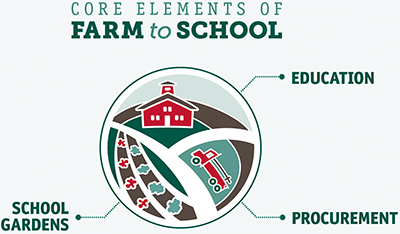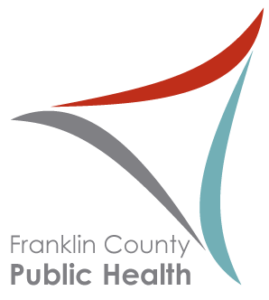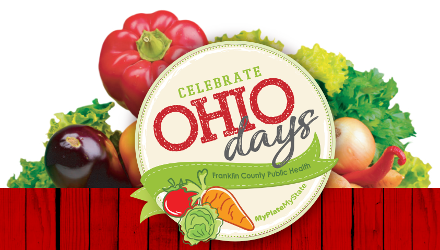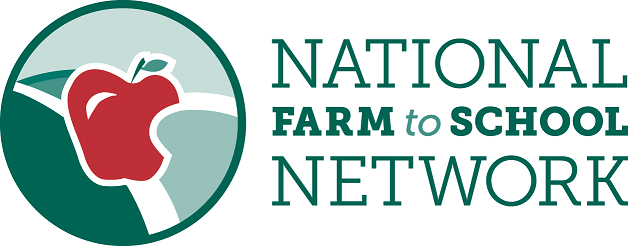The Farm to School initiative proposes to address food system sustainability problems at their roots through a three-pronged approach of education for school-age children, experiential learning in the form of school gardens, and local food procurement policies for schools. These actions directly promote student health and provide students with a foundation to make healthy and sustainable food choices, as well as fostering economic growth and sustainability in the form of a robust local food economy.
(Image credit: Franklin County Public Health)
Idea
The idea of Farm to School is simple: promote local food systems and their benefits by leveraging the education and outreach potential and procurement capacity of schools. The specific approach is left to the implementer, but usually consists of one or more of the following elements:
- Procurement of locally-produced foods for lunchtime meals or other uses within the schools
- Education of students in topics related to agriculture, food, health or nutrition
- Hands-on learning about food production through the use of school gardens

(Image credit: National Farm to School Network)
This approach is a win-win-win for kids, farmers, and communities:
- Kids gain access to nutritious foods that are likely to be fresher and less-processed due to the shorter supply chains required. They also gain knowlege that will enable them to pursue healthy lifelong eating habits, and perhaps even gain experiences that help prepare them for jobs in the agricultural sector.
- Food producers enjoy a predictable outlet for their produce with simpler marketing and distribution requirements, and may gain exposure to that lead to additional sales opportunities.
- Communities benefit from greater community engagement, creation and preservation of local jobs, and accelerated generation of community wealth due to recirculation of money in the local economy.
The benefits to kids and food producers are difficult to quantify, but the National Farm to School Network, in conjunction with Colorado State University, produced a report that clearly identifies some of the key economic benefits based on case studies in Minneapolis and Georgia (Christensen, 2017). The results are summarized in an associated fact sheet. For the Minneapolis case studies, the findings demonstrate the following benefits of investment in the farm to school production sector vs. the non-farm to school production sector.
| Non-farm to school production sector | Farm to school production sector | Page | |
|---|---|---|---|
| Dollars kept in the region per $100 dollar spent | $70 | $82 | p. 32 |
| Economic output multiplier | 1.62 | 1.93 | p. 36 |
| Employment multiplier | 1.67 | 1.96 | p. 36 |
These findings make a strong case for investment in Farm to School initiatives.
Goal
Issue a City Council resolution to encourage Whitehall City Schools to participate in the Farm to Schools movement by committing to the following:
- Form a Farm to School committee composed of district staff, students, parents, and local food producers to plan and implement Farm to School initiatives.
- Serve at least one meal per month in the school cafeterias that is entirely grown, raised and/or processed in Ohio.
- Establish and maintain a school garden at every school in the district.
- Encourage high school students to form a gardening club with a mission to maintain the school gardens and engage younger students.
Objectives
- Meet with staff from Franklin County Public Health to assess the current state of Farm to School efforts in the county and identify ways that the city government can assist in bringing these efforts to Whitehall.
- Meet with school district administrators to gauge interest and capacity to engage in Farm to School activities
- Draft a resolution to encourage Whitehall City Schools to participate in the Farm to Schools movement (refer to the Goals section)
- Formally adopt the resolution by vote of Whitehall City Council.
- Meet with school district administrators to deliver the resolution and discuss ways that the city government can support the effort.
Resources and Examples

(Image credit: Franklin County Public Health)
Franklin County Public Health (FCPH) is committed to ensuring the health of students throughout the county and is a strong advocate of local Farm to School programs and the Ohio Days: My State, My Plate program (more on this below). City of Whitehall representatives and delegates may contact the FCPH Farm to School Coordinator directly using the information provided on this contact sheet. Others should reach out to FCPH using their public contact channels.

(Image credit: Ohio State University Extension)
The Ohio State University Extension is a wealth of information about Farm to School and local food systems in general, but they provide a particularly useful resource called the Ohio Food Guide for Food Service Directors. This document is intended to help food service directors make meal plans and procurement decisions and provides a list of local food producers broken down by nutrition category (fruits, vegetables, protein, grain, and dairy) as well as a graphical depiction of when various fruits and vegetables are in season in Ohio.

(Image credit: Columbus City Schools)
Columbus City Schools (CCS) began participating in the Ohio Days program in 2017. They produced this video about their early experiences:
An article from Farm Flavor discusses some of the challenges that CCS had to address, including difficulty sourcing enough food for the districts 52,000 students, and handling processing operations (e.g. washing 6,000 pounds of strawberries) that the producers were not equipped to handle. In spite of the extra effort, the district values the program and intends to continue it. Because Whitehall City Schools serves a much smaller student population (3,400 students in 2016-2017), the district may not face the same issues of scale.
In June of the same year, Columbus City Schools was awarded a $100K grant from the USDA to slice and serve apples procured from Ohio farms. The USDA has the following to say about the grant:
The "Bigger Procurement, Smaller Bites" project involves purchasing equipment that will clean, slice, preserve, weigh, and bag local apples with the capacity to expand to additional fresh, local produce including, but not limited to, carrots, cucumbers, and squash. Ohio apples are a natural first choice in Columbus City Schools' (CCS) efforts to offer more sliced, fresh, local fruit in their cafeterias. The project will further strengthen the relationships developed between CCS Food Service and local food system partners.

(Image credit: National Farm to School Network)
The National Farm to School Network is an information, advocacy and networking organization dedicated to helping communities bring local food sourcing, school gardens and food and agriculture education into schools and early care and education settings. Their Resources page aggregates helpful documents and websites from a variety of organizations on topics including:
- Getting started with Farm to School
- Starting and maintaining school gardens
- Gardening-focused lesson plans
- School garden cookbook
Connection to Other Plans
| Element | Description | Rationale |
|---|---|---|
| 1.1 | Reduce vehicle miles traveled (VMT). | Food grown on local farms and/or processed by local operators requires less transportation. |
| 1.6 | Reduce per capita energy consumption across all sectors. | Food grown on local farms and/or processed by local operators requires less transportation. |
| 2.1 | Reduce emissions to meet federal air quality standards. | Food grown on local farms and/or processed by local operators requires less transportation. |
| 2.3 | Reduce the amount of municipal solid waste per capita disposed in the landfill. | Shorter supply chain and less transportation generates less intermediate packaging and potentially less food waste. |
| 3.1 | Increase the number of businesses in Central Ohio with established sustainability policies and practices. | Require adherence to sustainability practices as condition for procurement contracts. |
| 3.2 | Increase the number of adopted institutional purchasing policies that support the purchase of local food. | This is an explicit goal of Farm to School |
This idea potentially addresses the following elements of the Columbus and Franklin County Local Food Action Plan
| Element | Description | Rationale |
|---|---|---|
| B-8 | Public and institutional buyers adopt and implement food purchasing policies to support increased purchases of healthy and local food | This is an explicit goal of Farm to School. |
| B-9 | Support the development of a comprehensive network of educational resources and infrastructure that connects residents with healthy, affordable and local food | Kids are exposed to educational resources directly through Farm to School. Parents are exposed directly or indirectly by way of resources sent home with students. |
| B-10 | Engage those most impacted by health disparities, including low-income, African American, Hispanic, New American and other underrepresented communities, in developing and implementing culturally appropriate food assistance, education, nutrition, gardening and cooking programs | Marginalized groups are represented in the schools. Reduced reliance on large scale food distributors provides opportunities for meal plans more closely tailored to the needs of these groups. |
| B-11 | Incorporate onsite nutrition education and counseling, shopping strategies and healthy food purchasing incentives at food retail | Cafeteria personnel can counsel students in the lunch room. National Farm to School Network recommends posting signage and bulletin boards. |
| B-12 | Support the expansion of nutrition and food system education in Pre-K-12 curricula. | This is an explicit goal of Farm to School. |
| D-1 | Expand food waste prevention education campaigns for consumers, local governments, Pre-K-12 and food businesses. | This can be included in the recommended education program. For example, National Farm to School Network offers resources related to composting. |
References
Christensen, L., et. al. (2017, September). Economic Impacts of Farm to School: Case Studies and Assessment Tools. National Farm to School Network. Retrieved on April 7, 2018 from http://www.farmtoschool.org/Resources/EconomicImpactReport.pdf.
